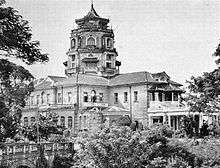Lim Chin Tsong
| Lim Chin Tsong | |
|---|---|
 Lim Chin Tsong and his wife, Tan Guat Tean, in 1920 | |
| Native name | 林振宗 |
| Born |
28 October 1867 British Burma |
| Died |
5 November 1923 (aged 56) Rangoon, British Burma |
| Occupation | Entrepreneur |
| Spouse(s) | Tan Guat Tean |
| Children | Lim Kar Chang, Lim Kar Hin, Lim Kar Kim, Lim Kar Taik, Lim Kar Tye, Lim Gaik Kee, |

Lim Chin Tsong (Chinese: 林振宗; Pe̍h-ōe-jī: Lîm Chín-chong; Burmese: လင်းချင်းချောင်း) was a Burmese Chinese tycoon and merchant, with business interests ranging from rice to oil.[1] Throughout his career, he served as the sole partner of Lim Soo Hean & Company, originally established by his father, a Chinese emigre to Burma.[2]
Early life and education
Lim was born on 28 October 1867 to Lim Soo Hean (林仕興), a Chinese of Hokkien origin who migrated from Amoy to Burma in 1861.[3][4] His father was a businessman who established Chop Lim Soo Hean (林仕興商行), a rice trading firm.[1]
Lim was educated at English language schools and attended Rangoon College and St. Paul's School (now BEHS No. 6 Botataung).[3][5] He also spoke Chinese, but was not literate in the language.[6]
Career

Lim and his partners also established Seang Taik & Company (雙德公司), an international enterprise.[1] He established a bank, Xie De Yuan (協德園), which was acquired by Nam Hwa Bank, a Japanese-owned firm after it went bankrupt.[1]
In 1888, after his father's death, Lim took over the enterprise and expanded from the rice trade to petroleum.[3] In 1891, he became the exclusive local agent of Burmah Oil Company, handling both the internal distributor of oil throughout Burma and expanding to the export of oil, to Penang, Singapore, Hong Kong, Swatow (now Shantou) and Amoy (now Xiamen) by acquiring a series of steamers that eventually led to the formation of the China Steamship Company.[3][4] Lim diversified his business interests into rubber plantations, cotton gins, peanut mills, and into earth metal extraction, including tin, copper, lead, wolfram and gold.[3]
In 1905, Lim and his partners established Anglo-Chinese Boys' and Girls' Schools in Rangoon (中華義學), Anglo-vernacular schools in Rangoon.[1][7] In 1907, Lim founded the Lim Chin Tsong School (林振宗中西學校).[1] Lim Chin Tsong served as a member of the Legislative Council of Burma.
In 1919, he was awarded the Order of the British Empire for his fundraising efforts during World War I.[3] Lim became the owner of Rangoon Turf Club, a racing stable. In 1918, he built the Lim Chin Tsong Palace, a lavish residence in Rangoon near Kokkine Road and built at a cost of 2,220,000 rupees.[3][8] The lavishly appointed murals at the residence were painted by Dod and Ernest Procter, English artists.[9]
In 1921, the British government banned the sale of rice in Burma except to India, because of steep increases in the price of rice.[3] Because of this ban, the rice market in Burma collapsed.[3] Lim died of a heart attack while sleeping, on 5 November 1923 following a bout of influenza.[3][4][10] His estate was declared insolvent on 10 June 1924.[10]
Family
Lim was married to Tan Guat Tean (Po U in Burmese).[6] The couple had 8 children, including Lim Kar Chang, Lim Kar Hin, Lim Kar Kim, Lim Kar Taik, Lim Kar Tye, Lim Gaik Kee. His second eldest son, Lim Kar Hin, died on 11 November 1916, preceding his father.[11]
References
- 1 2 3 4 5 6 Suryadinata, Leo (2012). Southeast Asian Personalities of Chinese Descent: A Biographical Dictionary. 2. Institute of Southeast Asian Studies. pp. 4,. ISBN 9789814414135.
- ↑ Shaw, J. (1929). "Khoo Sain Ban vs Tan Guat Tean on 11 March, 1929". Bombay High Court. Government of British India. Retrieved 21 September 2013.
- 1 2 3 4 5 6 7 8 9 10 Latham, A.J.H. (1988). "From Competition to Constraint: The International Rice Trade in the Nineteeth and Twentieth Centuries" (PDF). Business and Economic History. Business History Conference. Retrieved 21 September 2013.
- 1 2 3 "Late Mr. Lim Chim Tsong, O.B.E.". The Straits Times. 14 November 1923. Retrieved 21 September 2013.
- ↑ Wright, Arnold (1910). Twentieth century impressions of Burma. London: Lloyd's Greater Britain Publishing Company.
- 1 2 "Lim Chin Tsong". The Bull Wheel. BP. Retrieved 21 September 2013.
- ↑ "Chinese Schools in Rangoon". The Singapore Free Press and Mercantile Advertiser. 2 April 1910. Retrieved 21 September 2013.
- ↑ The South African Journal of Economic History. `. Economic History Society of Southern Africa. 1986. pp. 13–14.
- ↑ "Old Rangoon Gallery". Yangon Heritage Trust. Retrieved 21 September 2013.
- 1 2 Latham, John; Heita Kawakatsu (2012). Intra-Asian Trade and the World Market. Routledge. p. 135. ISBN 9781134194087.
- ↑ "Death". The Straits Times. Lee Kong Chian Reference Library. 24 November 1916. Retrieved 21 September 2013.